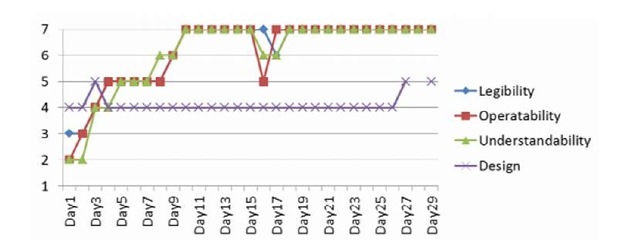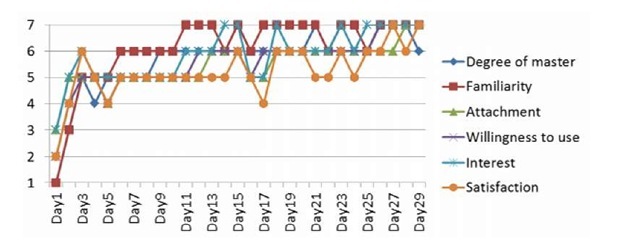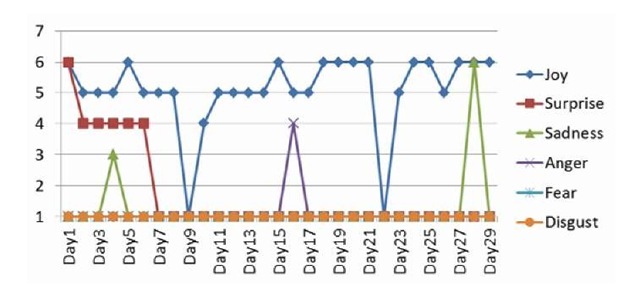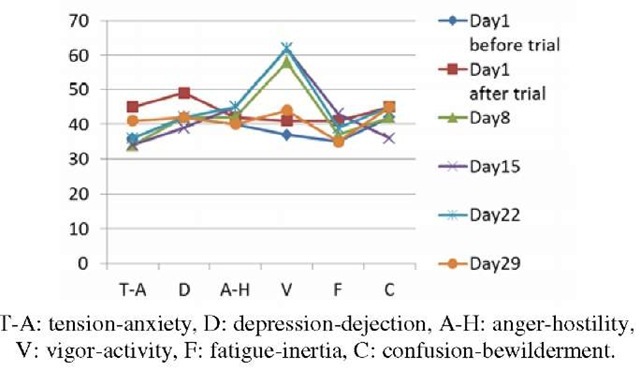Abstract
Our daily lives are supported by various technologies. Generally said, however, older adults cannot benefit from technologies due to difficulties with use of them. As some difficulties seem to be related with the fact that older adults require more time to get used to a new thing, and it is suggested that affectiveness may facilitate of use of technologies, this study tried to clarify the influence of continuous use of portable game system on older adults’ everyday life and emotion. By four-week continuous use of portable game system, some influence of it on older adults’ everyday life and emotion was confirmed. The results suggested the possibility that older adults could utilize technologies which originally aimed at younger users and affectiveness could facilitate it.
Keywords: affective technology, long term usability, behavior observation, POMS, emotion.
Introduction
Fun Technologies for Older Adults
In Japan, many video game systems are developed and provided in the market. Younger generation is very familiar with such game systems. We see small children and younger adults playing with portable game systems everywhere, even in the train or on the street. They enjoy playing games very much.
Conventionally, such game systems and software aimed younger users mainly. Recently, however, some elderly-aiming games have also been developed. For example, Nintendo produces games which can be enjoyed by all the family members together, regardless to generation. Supposed difficulties for older adults are, for instance, un-familiarity with conventional game controllers and visibility of the display of game system. Nintendo Wii with a special controller like a conventional remote controller for television or Nintendo DSi LL1 which has larger touch panel display have potential to diminish such difficulties. With regard to software, instead of conventional arcade games, shooting games, or role playing games, so called "brain training" games or fitness training games aiming older adults have been produced.
Such games seem to be acceptable for elderly users who are conscious about physical and/or mental health. How is the reality? Recently in Japan, older adults are getting familiar with arcade games or video games than before. Although games with violence (e.g. violent ‘first-person shooter’ games) are perceived negatively by older adults ([7]; [8]), strategy games or role-playing games may bring older adults some cognitive benefits [11]. Above mentioned brain training games and/or fitness training games attracted many older adults. Their "effects" have already been validated in some research works (e.g. [2]; [10]). Though such objective data is still limited and more empirical studies are required, it is assumed that some kind of games might have some influence on users.
What do older adults expect for playing games? Of course, it is suggested that older adults hope keeping their physical or mental health. In addition, some "indirect" effect on physical or mental health could be expected. For instance, they can talk about video games with other people, including younger generation. Or competition with other people could also facilitate to keeping physical or mental health of the elderly.
Necessity of Long Term Evaluation
If we think about the above mentioned issue, we should regard not only the first impression, but also change in impression during continuous use. Especially for older adults, the first step is hard. Game systems are not familiar for most of the older adults. Some older adults are even afraid that they may break the game player. Other older adults say "game systems are for younger adults, not for the elderly" and have no interests on such game systems at the first time. However, such impression will be changed by experience in use. An opportunity to contact with such game systems should be given to older adults at first.
Then sufficient time to gain some experiences is required. Older adults require more time to learn or to get used to something new than younger adults. Older adults tend to blame experienced or assumed difficulties with technology use on themselves [3]. Frequently they say "Yet I am not used with this system. Assumingly I can operate it better when I get into it." It suggests the problem with lack of experience. In fact, our research work on continuous use of skin lotion ([4]; [9]) showed that impression was changed by continuous use and became constant after certain period. Other researchers have also pointed out the importance of the evaluation of long term usability (e.g. [1]). Such research studies are generally accomplished by interview or subjective evaluation. On the other hand, writing diary is also applied frequently in order to get data every day.
Long term usability for older adults is not much studied. Imai et al. [5] have discussed the methodology of evaluation of long term usability by older users, but no concrete result was shown regarding effect of continuous use on impression on products. It is necessary to show how older adults get used to use an unfamiliar product.
Purpose
From the above background, this study aimed to clarify the influence of continuous use of portable game system on older adults’ everyday life and emotion.
Method
Participants
5 males and 3 females between 67 and 80 years (average = 73.5) participated in this experiment. All the participants had never played this type of portable game system.
Apparatus
Nintendo DSi LL ("DS") was applied in this experiment. DS has two screens including one touch panel and is operated by a stylus.
Three games were mainly focused in this experiment. The first one was "Personal Trainer Walking" ("Personal Trainer"). It is a kind of health monitoring system, which collects step data from an "activity meter" via infrared interface. The data is available in various formats, such as step numbers per day and diagrams of step numbers in every hour, and health advice based on the data is offered. In addition, some games related with the recorded number of steps are also available. The second was "Brain Age Express: Math" ("BA Math"), which provided various calculations and other mathematical exercises. The last one was "Brain Age Express: Arts & Letters" ("BA Letters") including writing Chinese characters, loud reading of novels, remembering pictures, etc.
Procedure
This experiment consisted of three parts: first trial, four-week continuous use, and final evaluation.
First Trial
The overview of this experiment was explained to the participants at first. After obtaining informed consent, we asked the participants to answer the brief form of Profile of Mood Status (POMS). The POMS assessment provides a rapid, economical method of assessing transient, fluctuating active mood states. As results, six factors will be derived: tension-anxiety, depression-dejection, anger-hostility, fatigue-inertia, vigor-activity, and confusion-bewilderment.
Consequently, hands-on training of DS was given. The operation by participants during hands-on training was recorded by video camera, in order to identify difficulties for the participants.
After the training, the participants were asked their first impression on using DS including 7-point Likert scale. The evaluation items were as follows.
• Items related to usability Legibility, operatability, understandability, design
• Items related to long term usability Degree of mastering, familiarity, attachment, willingness to use, interest, satisfaction
• Basic emotion Joy, surprise, sadness, anger, fear, disgust
Four-Week Continuous Use
The participants were asked to use DS as they like for four weeks at home and take notes every day. The frequency and duration of using DS could arbitrarily be decided by the participants. A form for note was provided, in which tried contents and duration, experienced difficulties, and found features should be filled. Impression evaluation was also requested every day in the same way as evaluation of first impression. Additionally, the evaluation of mood by using POMS was accomplished once a week.
Final Evaluation
The evaluation of mood by using POMS was accomplished at first, and then the participants were asked to play DS as during four-week continuous use. At least checking the data of activity meters in Personal Trainer and playing one of BA were requested. During the participants were playing, their behavior were video recorded for the comparison with first trial. Afterwards the participants filled the evaluation form and answered to the questions about use of DS for four weeks.
Results
Performance in Game and Walking
The participants used the game system every day except on the days when they were away from their home due to trip etc. Log data showed that participants played DS regularly – checked the recorded number of the steps in Personal Trainer and tried several exercises in BA Math and/or BA Letters. The spent time was also relatively steady. If a new exercise was added in BA (BA offers more exercises according to the number of day played), play time tended to be longer. Other functions such as camera or dictionary were also allowed to try, but they were tried only few times by a part of participants.
Performance of walking was analyzed based on the daily number of steps. It was influenced by the activities of the participants. The data showed three levels of participants’ activities: stayed at home, went out for daily activities such as shopping, and went out for healthy/sports activities such as walking. Except two participants, the recorded number of steps in each level increased.
Performance in BA was analyzed based on diagrams showing recorded "Brain age" and other performance data such as number of correct answers, required time for answer, and score. In general, the performance data showed improvement. Detailed data showed different patterns in improvement. In some cases, the performance improved steadily, whereas in other cases, the performance improved only in the early phases. Few cases showed no improvement of performance. In other cases, performance data varied very much and never stabilized.
Rating of Game Systems
Regarding items related to usability (visibility, operatability, understandability, and design), the rating showed greater change in the first one week. Change in the second to forth week was generally smaller than in the first week. The ratings of six participants improved (Fig. 1), whereas the ratings of two remaining participants deteriorated on the second or third day and remained low until the end of the four-week trial period.
Fig. 1. Example of rating of items related to usability
Regarding items related to long term usability (degree of mastering, familiarity, attachment, willingness to use, interest, and satisfaction), the rating varied more than items related to usability (Fig. 2). In most cases, the rating was never stabilized even in the last phase of trial period. The rating of degree of master and familiarity showed an upward tendency.
Fig. 2. Example of rating of items related to long term usability
Fig. 3. Example of rating of emotion
Basic emotion (joy, surprise, sadness, anger, fear, and disgust) showed either greater change or slight change (Fig. 3). It was different according to participant and type of emotion. Joy and surprise was felt more frequently than other type of emotion.
Rating of Mood
Fig. 4 shows an example of POMS score. If the score of vigor-activity, which is the only positive factor, is higher than other negative factors, it means that the participant is vigorous. When presented on a graph, the profile assumes a characteristic shape that is called the ‘iceberg’ profile. This was in the case of five participants. For other three participants, the score of vigor-activity was same or lower than those of other items, which meant these participants were rather in negative mood.
Although comparison of the POMS data of four weeks showed no significant tendency, in the cases of four participants, POMS score on Day29, where final evaluation was accomplished, showed the more pronounced ‘iceberg’ profile than on Dayl.
Fig. 4. Example of POMS score
Behavior Observation
With regard to operation, tap with stylus was no problem, whereas hand writing was difficult for the participants. Handwritten numbers and characters were sometimes recognized wrongly. This tendency was especially strong for complex Chinese characters. The log data showed that this problem remained until end of the trial period. Even in the final evaluation, some participants had to try writing numbers and characters several times.
Difficulties with comprehension of the contents were frequently observed in the first trial. DS has two screens and only one screen is a touch panel. However, if an illustration of touch panel for the explanation of operation was displayed on non-touch panel screen, many participants tried to tap that illustration and were confused by it. Confusion was also observed with regard to a part of text instructions. Ambiguous expression or lack of detailed explanation also confused some participants. However, these difficulties with comprehension could be overcome by repeated trials. Some participants mentioned it in their log (e.g. "Gradually I understand what I should do."). In the final evaluation, no one was confused by the instructions or other contents.
Discussion
Influence of Use of DS on Everyday Life
In the interview at final evaluation, all the participants mentioned that they were conscious of the fact that they wore activity meter to varying degrees. Some participants who were strongly conscious of the number of steps made a great effort to walk. The feedback in various forms was perceived by the participants positively. Different from conventional pedometer, the participants could see the recorded data in graphic representation, so that they could easily compare the data on different days. Accomplishment of the target number of step motivated the participants. Advices offered by Personal Trainer attracted interests of the participants. All of these let the participants conscious of walking and keeping regular hours. As results, some participants walked more than before.
Regarding BA, the participants enjoyed them very much. Five participants played BA almost every day and some of them spent over one hour per day. "Brain age" changed differently from participant to participant: in the cases of some participants, great improvement was observed, whereas other participants showed little or no improvement. Although the participants showed different performance in BA, most of them commonly thought that it did not help them to think quicker or more flexibly. They enjoyed playing BA, but did not realize the effect.
At least, these experiences with DS let most of the participants got familiar with game system. Other influences were also confirmed in interview: they had more interest on other game systems, interest on "high-tech", or interest on something new. Generally said, all these things are regarded as products aiming at younger generation and older adults had not much interest on them. The results of this experiment showed the possibility that older adults have some interest on products originally aimed at younger adults. Not just one time, but several times or certain period for trial could help older adults to get familiar with the products. In that way, older adults are possibly motivated to use the product for longer time and such long term use can influence on their daily lives.
Influence of Use of DS on Emotion and Mood
As mentioned above, four-week experience in using DS had some influences on behavior level. Regarding influence on emotional level, common tendency was not clearly confirmed. However, in the most of the participants, joy and surprise were elicited, whereas other four categories of emotion were elicited less frequently. For affective technology, joy and surprise are very important to motivate users to use the technology. The strength of these emotions was decreased over time in the cases of some participants. It seems that the more the participants got used to DS, the more they regarded DS not as "special" but as "normal". At least, in order to elicit "surprise", something new will be required. The function of BA that offer new exercise after the user accomplished exercises certain times would be one good example for that. In order to let the users feel joy, positive feedback would be required. High scores in BA or greater number of steps in Personal Trainer delighted and motivated the participants very much. In that way, DS could affect the participants to some degree.
On the other hand, the clear effect of DS on mood was difficult to confirm. Different from rating of emotion, the score of POMS reflected not only the mood during trial, but also all other events happened. However, at least half of the participants had shown ‘iceberg’ profile in POMS after four-week continuous use. If DS was regularly used, even mood could be influenced by it.
From Usability Issue to Affectiveness
As mentioned in Introduction, some difficulties were assumed for older adults to use game systems. Actually, such difficulties were observed in the first trial. However, they could overcome or bear up the difficulties (e.g. hand-writing with stylus) by using the game system repeatedly.
Usability issue is regarded as one of the critical interferences for older adults to use technologies. The results of this experiment, however, showed that sometimes affec-tiveness came before usability. If a product or technology gives positive impression strongly, the users can be motivated to use it, even when the usability was not good.
Of course, it does not mean that usability can be ignored. Usability should be secured and it is minimum requirement. But a product or technology with only good usability may not be attractive. Some affectiveness would be required.
Conclusion
By four-week continuous use of portable game system, some influence of it on older adults’ everyday life and emotion was confirmed. The results suggested the possibility that older adults could utilize technologies which originally aimed at younger users. Affectiveness could facilitate it.




